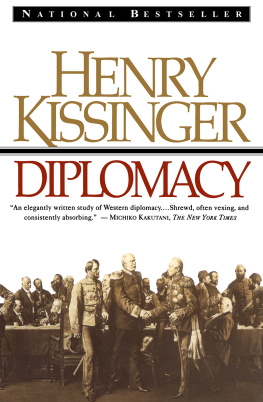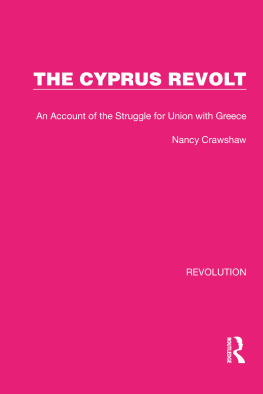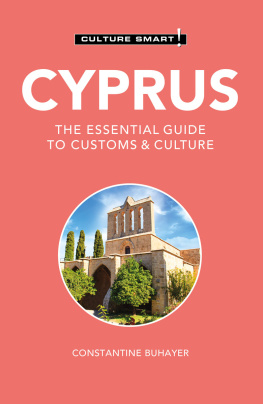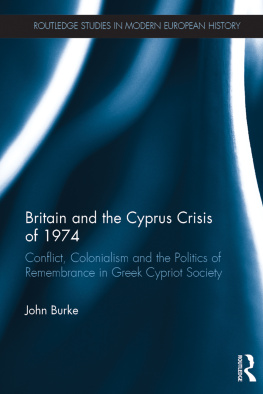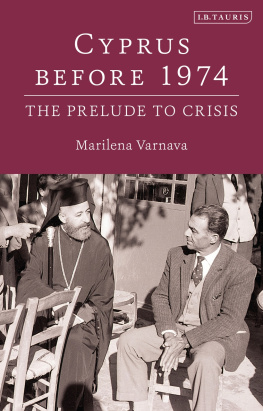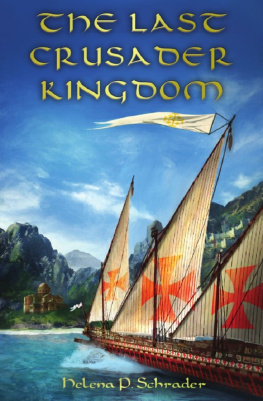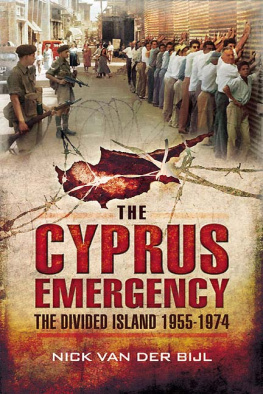As this definitive history shows, our betrayal of the people of Cyprus Turkish and Greek remains a shameful episode in British post-colonial history and Americas conduct of the Cold War.
John Torode, Hampstead and Highgate Express
[T]his book offers much that is new for historians interested in Cyprus and the interplay of NATO and UN policy-making.
Constantine Buhayer, Anglo-Hellenic Review
This well written and well researched account of events provides the understanding of the situation and the causes which led to the escalation of the crisis in 1974.
Konstantinos Kotzias, Contemporary Review
OMalley and Craig show how powerful and penetrating journalism can be by producing a book of high quality and academic value. This book fills a gap in the literature about Cyprus and the Cyprus problem, and will also be of interest to those working on the eastern Mediterranean, and on US and British foreign policy in the region.
Mediterranean Politics
This extremely well researched book by Brendan OMalley and Ian Craig adds to our understanding of how this small country could become drenched in so much bloodshed and interethnic strife.
Kevin Ovenden, Socialist Review
The Cyprus Conspiracy delivers new and damning detail on how the big powers (including good old ethical Britain) taught Greek Cypriots and Turkish Cypriots not to live together.
Guardian
A marvellous new bookIt is a fascinating story of international intrigue, espionage and intelligence, brilliantly and graphically told and it will open a lot of eyes of people who, until now, had no inkling until today about the real and intriguing reason behind the partition of Cyprus.
Chris Moncrieff, House
It is recommended reading for those seeking to understand one of the most lengthy and bitter conflicts in Europe from a historical context as well as an illustration of the supremacy of realpolitik at the height of the Cold War.
Journal of Peace Research
To my mother, Marie,
and to the memory of my father, John
Brendan OMalley
To my parents,
Jack and Olwen
Ian Craig

Reprinted in 2011 by I.B.Tauris & Co Ltd
6 Salem Road, London W2 4BU
175 Fifth Avenue, New York NY 10010
www.ibtauris.com
In the United States and Canada distributed by St. Martins Press
175 Fifth Avenue, New York NY 10010
First published in 1999 by I.B.Tauris & Co Ltd
Copyright Brendan OMalley and Ian Craig, 1999, 2000, 2001, 2002
Reprinted in paperback 2004, 2005, 2006, 2007, 2008, 2009
The right of Brendan OMalley and Ian Craig to be identified as the authors of this work has been asserted by the authors in accordance with the Copyright, Designs and Patents Act 1988.
All rights reserved. Except for brief quotations in a review, this book, or any part thereof, may not be reproduced, stored in or introduced into a retrieval system, or transmitted, in any form or by any means, electronic, mechanical, photocopying, recording or otherwise, without the prior written permission of the publisher.
ISBN 978 1 86064 737 6
eISBN 978 0 85773 016 9
A full CIP record for this book is available from the British Library
A full CIP record for this book is available from the Library of Congress
Library of Congress catalog card: available
Typeset in Baskerville 11/12pt by The Midlands Book Typesetting Co. Loughborough
LIST OF ILLUSTRATIONS
Maps |
Plates | 1 In the 1950s, Britain tried to crush the Cypriot uprising. |
2 Archbishop Makarios in 1959 with EOKA leader George Grivas. |
3 A blood-stained bath preserved in the Museum of Barbarism, Nicosia. |
4 George Ball, US Acting Secretary of State. |
5 A Turkish soldier during the invasion of 1974. There are 1,600 Greek Cypriots still missing after the invasion and 200,000 refugees unable to return home. |
6 A Greek-Cypriot girl with a picture of a lost loved one. There are 1,600 Greek Cypriots still missing after the invasion and 200,000 refugees unable to return home. |
7 Secretary of State and National Security Adviser Henry Kissinger. |
8 British Foreign Secretary James Callaghan. |
9 Glafkos Clerides, president of the Republic of Cyprus today and acting president in 1974. |
10 Rauf Denktash, Turkish-Cypriot leader in 1974 and now president of the Turkish Republic of Northern Cyprus. |
11 Henry Kissinger with Brendan OMalley, spring 1999. |
PREFACE
The trigger for our search for the real story behind the Cyprus crisis which has left the island divided to this day was an unguarded remark made by James Callaghan. Sipping a glass of wine on the terrace of the House of Commons, Callaghan, who was Foreign Secretary in 1974, spoke emotionally of his role in the dramatic events to a fellow MP: It was the most frightening moment of my career, he said. We nearly went to war with Turkey. But the Americans stopped us.
Our curiosity aroused, we asked Callaghan to elaborate, but he insisted on seeing our questions in advance and, when he saw them, declined to be interviewed. Harold Wilson and then Defence Secretary Roy Mason also declined. That set us off on a long hunt for the truth. We wanted to know why Greece staged a coup against Cyprus and tried to assassinate its President, why Turkey retaliated with a full-scale invasion, and why Britain sent a military task force but took no action when all three powers were supposed to be guarantors of Cypruss independence.
The more we looked into it, the more complex the Cyprus jigsaw became, and at every important turn there was the hand of the CIA or the US State Department.
Our investigation involved deep research through top secret files, released in Britain and America, including Defence, Foreign Office and Colonial Office papers, Cabinet minutes, State Department and CIA papers, and interviews with a number of those closest to the crisis. History records that Cyprus was divided because of a Greek-inspired coup and a Turkish invasion. We discovered that the truth was considerably more complex. It was a conspiracy by America, as Britain stood by, to divide the island. And the reason, ignored by previous studies of the Cyprus crisis, was the islands strategic value as a military and intelligence base as well as Americas considerable military interests in Turkey. These swamped all other considerations as far as America was concerned. In fact they have done so in all British and American policy over Cyprus in the past 50 years.
This book explodes the myth that Cyprus is divided today purely because of ethnic hatred. It reveals an astonishing international plot, developed from a blueprint evolved first under British rule, then by US President Johnsons officials, the goals of which were finally realised in 1974 even as the Watergate scandal reached its climax.
There are many people, too numerous to mention, who have helped us with this investigation, but we would like to offer our special thanks to the staff of the Public Records Office at Kew, the British Library in London, Colindale and Leeds and the House of Commons library, whose service and resources were invaluable to our research; to former US Secretary of State Dr Henry Kissinger, the Cypriot leaders on both sides including Glafkos Clerides, Rauf Denktash, the late Ezekias Pappiannou, Vassos Lyssarides and Kenan Attakol, and Callaghans former political aide Lord McNally, who allowed us to interview them; to the press offices of the Cypriot Government in Nicosia, the Turkish Republic of North Cyprus and the Ministry of Defence in Whitehall; to electronic intelligence experts Professor Jeffrey Richelson and Professor Desmond Ball, and investigative journalist Duncan Campbell; and to distinguished Turkish journalist Mehmet Ali Birand for their help.


